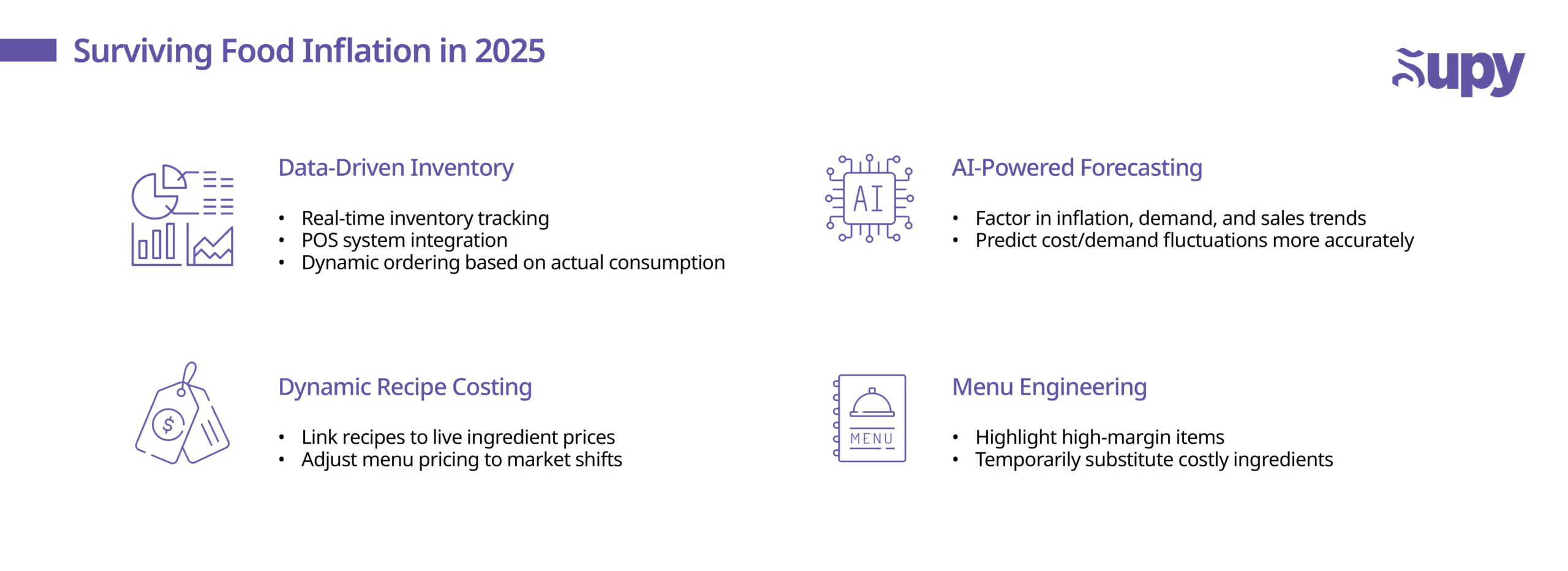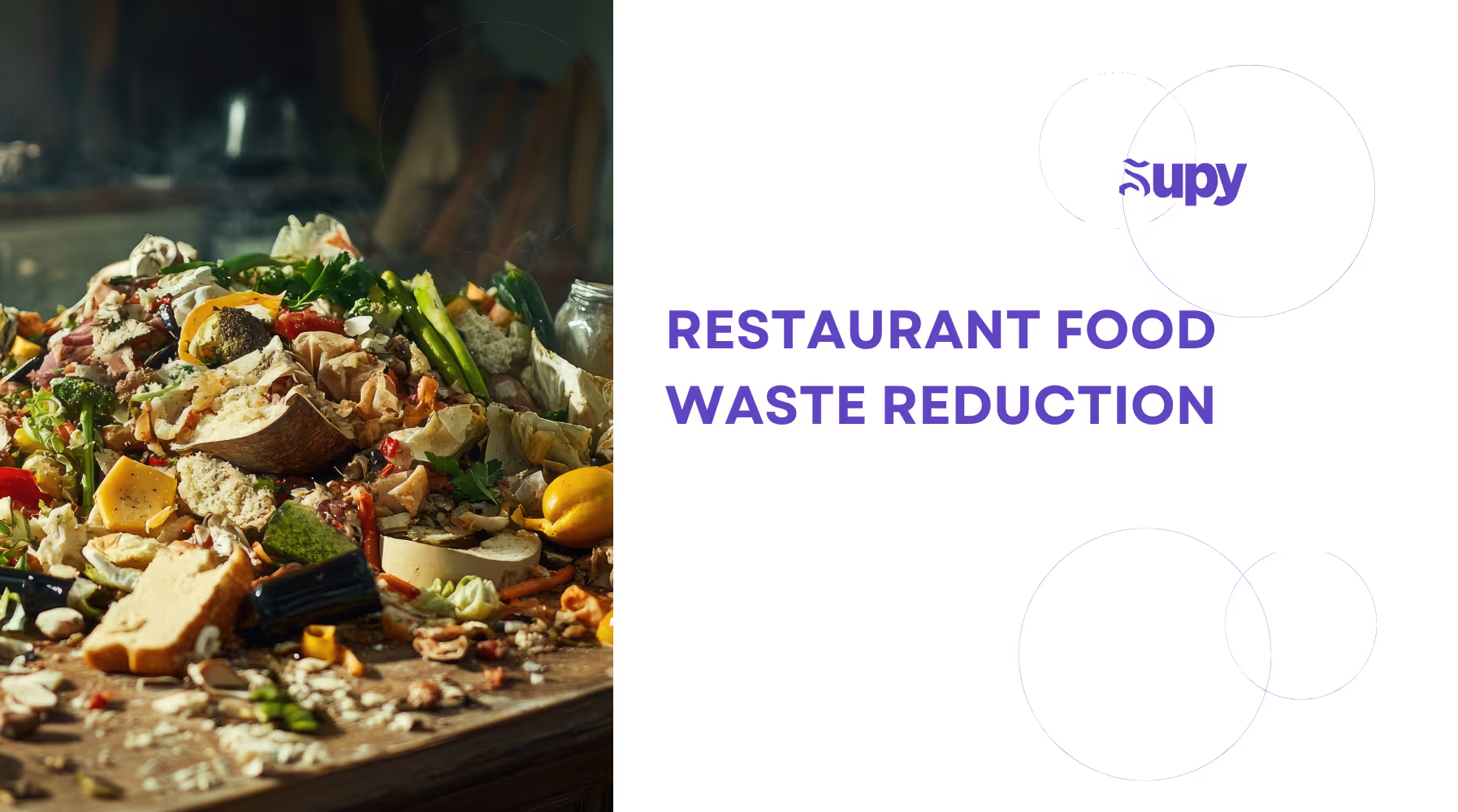How Multi-Branch Restaurants Can Navigate Food Inflation in 2025

Food inflation is nothing new, but in 2025, it’s proven to be one of the most persistent challenges for the food and beverage industry. At its core, food inflation refers to the rising cost of ingredients due to economic shifts, global supply chain disruptions, and unpredictable weather patterns. For multi-branch restaurant operators, this means your go-to supplier might decide to unexpectedly raise their prices or that your usual cost of goods sold (COGS) might fluctuate from week to week. All of this puts your once-reliable margins under threat.In a pressurised environment like this, traditional inventory and procurement methods simply won’t cut it. As a restaurant owner or operator, if you’re still relying on gut feelings or outdated spreadsheets, there’s absolutely no question that you’re leaving money at the table.The good news? There are smarter, more proactive ways to navigate food inflation.
- Understanding the Effects of Food Inflation in 2025
- Key Challenges for Multi-Branch Operators
- Regular Stock Counts to Avoid Overstocking
- Real-Time Inventory Tracking to Catch Discrepancies
- Setting and Monitoring Par Levels
- Optimize Recipe Costing and Menu Pricing
- Compare Suppliers and Integrate with POS Systems
- Forecast Demand More Accurately
- Automate GRNs and Invoice Scanning
- Track Price Trends Over Time
- Centralized Inventory for Multi-Location Control
- Conclusion
- About Supy
In this guide we outline some of the key strategies that can help you regain control of your food costs, tighten your margins, and stay profitable across all branches. From real-time inventory tracking to dynamic recipe costing, you’ll learn how tools like Supy can support you at every step of the way.
1. Understanding the Effects of Food Inflation in 2025

It’s no secret that food inflation continues to challenge the restaurant industry in 2025, with prices for food-away-from-home increasing by 3.7% over the past year. This trend is particularly burdensome for multi-branch restaurants, which must manage larger cost of goods sold (COGS) and navigate complex supply chains.Add to this the fact that essential ingredients like beef, chicken, and fresh vegetables have experienced significant price hikes, with beef and veal prices rising by 7.6% year-over-year. Is it any wonder then that such volatility complicates budgeting and forecasting? You might as well need a genie in a bottle to turn a profit.Many traditional inventory methods also often fall short in this kind of environment. Without real-time data, many restaurants risk over- or under-ordering, leading to increased waste or missed sales opportunities. Moreover, inconsistent recipe costing can result in menu prices that fail to reflect current ingredient costs, further eroding your margins. What’s a poor restaurant owner to do?
2. Key Challenges for Multi-Branch Operators

One of the biggest headaches for multi-branch restaurant operators in this environment is the unpredictability of their cost of goods sold (COGS). Ingredient prices are fluctuating week to week—sometimes even day to day—making it harder than ever to maintain accurate cost projections.Without a clear, real-time view across all of their locations, restaurant operators risk over-ordering at one branch while they under-stock at another. Many teams still rely on outdated spreadsheets or other siloed and disconnected inventory tools, which can’t keep up with sudden supplier changes. This lack of visibility slows down the decision-making process, especially when supplier prices spike unexpectedly or delivery quantities fall short.By the time you notice a problem, the cost impact has already hit your bottom line. But don’t worry, Supy’s got an action plan for you.
3. Regular Stock Counts to Avoid Overstocking
In an inflationary environment, over-ordering doesn’t just tie up your cash—it actively erodes your margins. When food prices are rising fast, every wasted tomato or overstocked cut of meat costs more than it did last month. Indeed, overstocking leads to spoilage, shrinkage, and sunk costs…and when you're operating multiple branches, each of those losses can snowball fast.That’s why a good restaurant operator or manager understands the importance of consistent stock counts. A weekly stock take (or even more frequently for fast-moving perishables) helps make sure your inventory levels reflect your actual sales. With Supy, parallel stock counting becomes faster, easier, and more precise. Our mobile-first interface allows your team to perform stock counts directly from their devices, instantly updating your inventory system in real time across all branches.
4. Real-Time Inventory Tracking to Catch Discrepancies
When supplier prices rise and margins tighten, even small errors—like a missing case of tomatoes or an over-portioning issue—can snowball into major losses. The problem? Traditional weekly or manual stock checks are too slow to catch these variances before they start impacting your bottom line.That’s where real-time inventory tracking becomes necessary. With this feature, you gain immediate visibility into what's coming into your system, what's being used, and what’s going missing. Real time tracking lets you see shrinkage, pilferage, or data entry errors as they happen—not days or weeks after the fact.With Supy, operators gain access to live dashboards and automated alerts that flag discrepancies like these the moment they arise. Whether it's a sudden drop in inventory levels or unexpected usage spikes, you’ll be notified instantly, giving you time to investigate and act on the issue—before it turns into a loss.
5. Setting and Monitoring Par Levels
One of the simplest yet most powerful tools in your inventory toolbox is setting a defined par level. This refers to the ideal minimum stock quantity your restaurant needs for any given item. In times of inflation, where ingredient costs are constantly fluctuating and every dirham counts, having the right par levels helps you avoid two costly pitfalls:
- stockouts (which lose sales)
- overstocking (which increase waste)
But setting par levels isn’t a one time job. To truly navigate food inflation, you’ll need to figure out a way to dynamically adjust your par levels based on real-time sales data and seasonality. For example, if you find that demand for your signature item has dropped due to rising prices, your par for its ingredients should be set up to drop automatically too.Here’s where Supy gives you a major edge. Our restaurant procurement software comes with built in live inventory tracking. This means you can now monitor your consumption patterns in real time, update par levels accordingly, and then sync them across your locations with a single click.
6. Optimize Recipe Costing and Menu Pricing
Another thing to look out for when food costs start rising is your prices. Even small changes in ingredient costs—say, a 15% increase in cheese or oil—can dramatically impact the price of your most popular dishes. That’s why learning how to optimise your menu and recipe costs is essential for anyone trying to navigate food inflation.Step one is to review the cost breakdown of each menu item. Are there any premium ingredients you can reduce or substitute without compromising quality? Can you adjust portion sizes while still meeting guest expectations? Often, minor tweaks to your recipe can help you preserve your customers’ experience while keeping money safely in your pocket.By linking and regularly updating all ingredient costs to your recipes, Supy’s menu engineering services instantly send out alerts if ingredient prices increase and affect your recipe’s profitability. Our costing simulator also allows restaurant operators to simulate their potential revenue to maximize their profits. Supy lets you do this by working in reverse—set a target food cost to help determine the ideal price for your menu items. Then you can approximate the net revenue generated by each of your recipes to come up with that pricing sweet spot that satisfies both you and your customers!
7. Compare Suppliers and Integrate with POS Systems
Another smart way to beat inflation is to consider your supply chain. While some of your suppliers may be hiking up their prices, you’ll notice that others stay relatively stable…or even offer better deals on bulk orders. That’s why regularly comparing suppliers is one of the smartest ways to navigate food inflation. By reviewing prices across vendors for your most critical ingredients, you can identify where to shift your purchasing without compromising on quality.But supplier cost is just one side of the equation—your point-of-sale (POS) system holds the other half of the story: which ingredients actually drive profits. By integrating your inventory platform with your POS, you can link real-time sales data with ingredient costs. This reveals which menu items are most profitable—and which ones are dragging down your margins.Supy makes this process seamless. Its centralized purchasing tools allow you to track the value of your purchases across your suppliers and restaurant locations. With our restaurant analytics software, you can now identify your top suppliers and build business relationships that help you score sweeter deals!
8. Forecast Demand More Accurately
One of the most significant risks restaurants face during inflation is overproduction. When food prices are volatile, it’s certainly much trickier to estimate demand.To navigate food inflation effectively, using historical sales data and seasonal trends is essential. By analyzing past sales patterns, restaurants can better anticipate demand fluctuations, ensuring inventory levels align with actual needs. This helps prevent over-ordering and reduces waste.With our real-time reporting & forecast analytics, Supy's forecasting tools are designed to help you plan your operations better and order ingredients more accurately. By analyzing past sales and consumption patterns, these tools can estimate how much of each ingredient will be required for a given period. By accurately predicting demand, restaurants can keep costs in check while ensuring they always have the right amount of stock available.
9. Automate GRNs and Invoice Scanning
Manual data entry is a common source of errors and delays when it comes to recognizing price changes, which can be a significant problem during times of food inflation. As supplier prices fluctuate and flash rapidly, it’s absolutely necessary to make sure your invoices and deliveries are being accurately recorded in real time. This is where automating your Goods Received Notes (GRN) and invoice scanning can make a huge difference.Automating the GRN process speeds up the data capture process, ensuring that all received goods are recorded correctly and promptly. This eliminates the risk of human error, ensuring that price discrepancies are spotted quickly, rather than weeks later when the financial impact becomes more significant.With Supy’s digitized invoice recording feature, you can record every invoice you ever receive. Often considered one of the trickier aspects of managing a restaurant business, Supy helps restaurant leaders accelerate their invoice recording processes, boost their inventory accuracy, and manage statements of account that keep them in control of their payments at all times.
10. Track Price Trends Over Time
In times of food inflation, staying ahead of price fluctuations can be a game-changer. By tracking price trends over time, restaurants can identify long-term price increases, helping them make informed decisions on when to lock in bulk orders or renegotiate supplier contracts before prices climb further.Supy’s interactive and mobile-friendly restaurant dashboards are a great tool for owners and managers trying to keep an eye on all of their back-of-house operations. With the Restaurant Analytics feature, Supy makes it a breeze to check out your procurement, inventory, and sales stats at a single glance so that you’re always making data informed decisions!
11. Centralized Inventory for Multi-Location Control
Last but not least, in an inflationary environment, restaurants without a strong, standardised system of operation are bound to suffer. Without a strong predetermined plan, each branch of your restaurant may be operating with different purchasing methods and stock management processes. This lack of cohesion often leads to inefficiencies, such as over-ordering, stockouts, or discrepancies in pricing…all of which are deadly for your profit margins.Supy’s centralized platform is designed to help multi-location restaurants manage their inventory seamlessly. With live, real-time data across all branches, that means no more surprise costs or miscommunication between locations.With all their relevant data backed up on the cloud, restaurant owners and managers can proactively manage their waste, optimize their restaurant operations, and expand their sales channels with confidence!
12. Conclusion
Navigating food inflation in 2025 doesn’t have to feel like an insurmountable challenge. By proactively managing inventory, monitoring your recipe costs, and using real-time data to adjust purchasing decisions, you can maintain profitability even as prices continue to rise. The secret is to stay ahead of price fluctuations by regularly reviewing your stock levels and implementing systems that ensure you’re not wasting valuable ingredients.It’s about working smarter—not harder—and making sure your operations are built for sustainability, even in tough economic times.Ready to future-proof your inventory strategy? Supy helps you navigate food inflation with real-time data, automated cost tracking, and centralized control. Book a demo today and see how we can help your business thrive!
13. About Supy
Supy is the best restaurant inventory management software platform tailored for multi-branch restaurants and franchises. With features like real-time inventory tracking, smart procurement systems, and advanced analytics, Supy helps restaurants manage their various demands effectively and provides the tools restaurants need to thrive in a dynamic industry.For the latest expert insights, download Supy’s ebook: The Ultimate Guide to Reducing Food Costs in Multi-Branch & Enterprise Restaurants.Ready to find out more? Schedule a demo with Supy today and take the first step towards a streamlined, profitable future.







